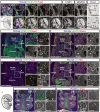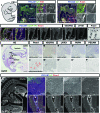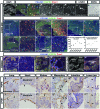The development of early human lymphatic vessels as characterized by lymphatic endothelial markers
- PMID: 38351385
- PMCID: PMC10907744
- DOI: 10.1038/s44318-024-00045-0
The development of early human lymphatic vessels as characterized by lymphatic endothelial markers
Abstract
Lymphatic vessel development studies in mice and zebrafish models have demonstrated that lymphatic endothelial cells (LECs) predominantly differentiate from venous endothelial cells via the expression of the transcription factor Prox1. However, LECs can also be generated from undifferentiated mesoderm, suggesting potential diversity in their precursor cell origins depending on the organ or anatomical location. Despite these advances, recapitulating human lymphatic malformations in animal models has been difficult, and considering lymphatic vasculature function varies widely between species, analysis of development directly in humans is needed. Here, we examined early lymphatic development in humans by analyzing the histology of 31 embryos and three 9-week-old fetuses. We found that human embryonic cardinal veins, which converged to form initial lymph sacs, produce Prox1-expressing LECs. Furthermore, we describe the lymphatic vessel development in various organs and observe organ-specific differences. These characterizations of the early development of human lymphatic vessels should help to better understand the evolution and phylogenetic relationships of lymphatic systems, and their roles in human disease.
Keywords: Cellular Origin of Lymphatic Endothelial Cells; Human Embryos; Lymphatic Vessel Development.
© 2024. The Author(s).
Conflict of interest statement
The authors declare no competing interests.
Figures










Similar articles
-
Migration of lymphatic endothelial cells and lymphatic vascular development in the craniofacial region of embryonic mice.Int J Dev Biol. 2018;62(4-5):293-301. doi: 10.1387/ijdb.170218yt. Int J Dev Biol. 2018. PMID: 29877568
-
The cardiopharyngeal mesoderm contributes to lymphatic vessel development in mouse.Elife. 2022 Oct 5;11:e81515. doi: 10.7554/eLife.81515. Elife. 2022. PMID: 36196867 Free PMC article.
-
Isl1-expressing non-venous cell lineage contributes to cardiac lymphatic vessel development.Dev Biol. 2019 Aug 15;452(2):134-143. doi: 10.1016/j.ydbio.2019.05.002. Epub 2019 May 18. Dev Biol. 2019. PMID: 31112709
-
Molecular and cellular mechanisms of lymphatic vascular maturation.Microvasc Res. 2014 Nov;96:16-22. doi: 10.1016/j.mvr.2014.06.002. Epub 2014 Jun 11. Microvasc Res. 2014. PMID: 24928499 Free PMC article. Review.
-
Lymphatic vessels of the eye - old questions - new insights.Ann Anat. 2019 Jan;221:1-16. doi: 10.1016/j.aanat.2018.08.004. Epub 2018 Sep 18. Ann Anat. 2019. PMID: 30240907 Review.
Cited by
-
Embryological cellular origins and hypoxia-mediated mechanisms in PIK3CA-driven refractory vascular malformations.EMBO Mol Med. 2025 Jun;17(6):1289-1324. doi: 10.1038/s44321-025-00235-1. Epub 2025 Apr 16. EMBO Mol Med. 2025. PMID: 40234712 Free PMC article.
-
Meningeal lymphatic drainage: novel insights into central nervous system disease.Signal Transduct Target Ther. 2025 May 5;10(1):142. doi: 10.1038/s41392-025-02177-z. Signal Transduct Target Ther. 2025. PMID: 40320416 Free PMC article. Review.
-
Lymphatic System Development and Function.Curr Cardiol Rep. 2024 Nov;26(11):1209-1219. doi: 10.1007/s11886-024-02120-8. Epub 2024 Aug 22. Curr Cardiol Rep. 2024. PMID: 39172295 Review.
-
Bridging the Gap: Endothelial Dysfunction and the Role of iPSC-Derived Endothelial Cells in Disease Modeling.Int J Mol Sci. 2024 Dec 11;25(24):13275. doi: 10.3390/ijms252413275. Int J Mol Sci. 2024. PMID: 39769040 Free PMC article. Review.
References
MeSH terms
Substances
Supplementary concepts
Grants and funding
LinkOut - more resources
Full Text Sources

